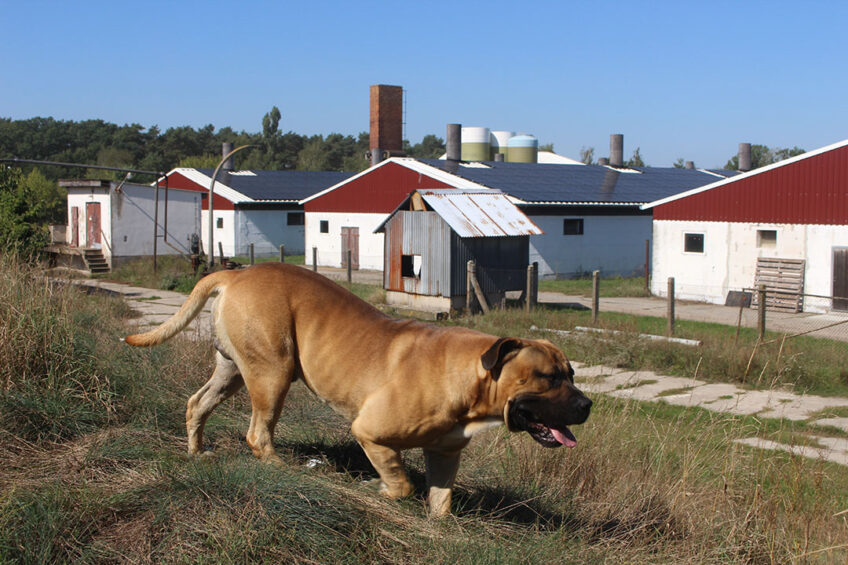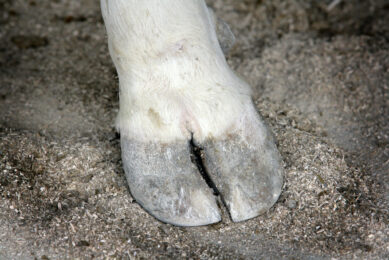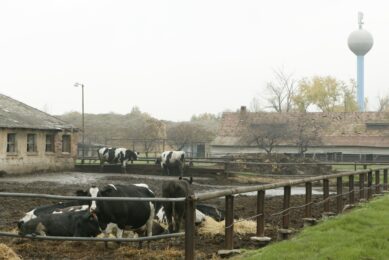Farm visit: “ASF is not even our biggest problem”

About a decade ago, Bart and Mascha Vennix bought a nice farm site with plenty of opportunities in eastern Germany. The farm layout was great, and the capital Berlin nearby provided an excellent marketplace for pork and permanent demand for pig manure, as the soil in that area can do with some help. Things looked rosy – then along came African Swine Fever in wild boar.
“It is funny the things you have to think twice about. We had wanted to redecorate our daughters’ bedrooms. Then we suddenly found ourselves asking each other: should we go ahead with it?”
This is just 1 random anecdote in the life of Bart, age 41, and Mascha Vennix, age 44, owners of swine farm Bremsdorf in the village Schlaubetal, Brandenburg state, Germany. They are originally Dutch and moved to Germany many years ago to work in the swine industry. They started out as managers at a farm site, but about 9 years ago, they decided to make the big move and buy a property of their own. Initially, they say, it was a matter of tremendously hard work with long days and a lot of investment. Bit by bit, however, things started to fall into place and their 4,800 finisher pig facility started paying off.
That is when September 2020 came, and African Swine Fever (ASF) was found in wild boar in Brandenburg state, radically changing the picture. Pigs reared in the state suddenly appeared suspect even if they were totally healthy and even though no farms were affected until July 2021. The location of the farm was reflected in the prices they were paid. In the months that followed, the farm suffered a loss of € 179,000, shown clearly in the management records.
The good old days
First, some basics. Bremsdorf farm breathes history. The robust pig houses were built when East Germany had a communist government, in the early 1970s. The farm was called a “Typanlage”, says Vennix. “At the time, 39 of these identical farms were built. I have visited some; most of them still exist. They are exactly the same and they definitely knew what they were doing back then. I’ve insured the farm for € 4.5 million. If the whole lot burns down, I want them to reconstruct it exactly as it is now.”
In the 1970s the farm had capacity for 7,500 finisher pigs. That has now been reduced to 4,800 or almost 1,000 per pig house, he says. The farm takes part in the German animal welfare scheme “Initiative Tierwohl”, which requires farms to have 1.2 m2 per animal.

The farm consists of 5 parallel finisher barns, made of concrete that has stood the test of time. A striking modern addition is the presence of solar panels on the roofs, generating 1.3 MW. The buildings are 8 m apart from each other and connected through a central sluice. In the layout of the farm, care is given to proper driveways that take into account biosecurity, with separate entrance routes for the pig trucks and the feed trucks. The entire complex is fenced off with 2 m high fences.
Pig delivery
Those fences are needed more than ever as Bremsdorf farm is located in a “white zone”. These are strips around core zones where wild boar are found infected with ASF virus, and they serve in practice as a zone for intensive hunting and increased surveillance against the virus. Bremsdorf is in a white zone in between 2 core zones. Unlike what happened in Belgium, the German authorities chose not to opt for immediate closure or culling for preventive reasons for farmers that were in risk areas. As a result the farm could continue to operate – but getting the pigs marketed did become more difficult as not all slaughterhouses were open to receive their pigs.

The result was a transport crisis for Vennix and his wife: until September 2020, the finished pigs could be delivered to a nearby slaughterhouse. Transport costs of a truckload of pigs were about € 550, the couple says. In September 2021, however, Vennix has to send his finished pigs to a slaughterhouse in the state of Schleswig-Holstein, a 7-hour journey, as no closer slaughterhouses appear keen to have his pigs – leading to a price of € 1,600 per transport, 2 or 3 times per week. Additionally, the prices offered are about € 0.16 lower than the market price because the animals were raised in an ASF-affected area. A high number of veterinary tests are also needed to confirm that all pigs are negative for ASF virus; now it is clear how a farm can lose € 179,000 in a year.
ASF is not the problem
Vennix: “In fact, ASF is not so much my problem. I do not even think we have that much of an ASF problem in this area anymore. Hunters tell me they do not find a lot of wild boar anymore. And one can see it at the soft shoulders of the road as well. When there are many wild boar, you can see it in the degree to which the vegetation has been eaten. There is no eating going on there now – the vegetation has been coming up.”
Vennix feels left alone – yet he is strongly hoping and calling for a signal of solidarity from meatpackers. In his view something needs to change to re-establish a slaughterhouse locally so business can continue for the farms in the ASF-affected states of Brandenburg and Saxony – as Vennix is certainly not the only one struggling to get by; some colleagues of his even had to keep their finisher pigs onsite when they had gone over 145 kg. He proposes one central slaughterhouse where all the required testing can be coordinated, with the added bonus that animal welfare is not compromised by unnecessarily long truck drives.
He says, “It is possible as well. In the affected area I think there is a capacity for around 60,000 pigs. Only a few years back they closed down a local slaughterhouse in Kasel-Golzig that could manage that number of finisher pigs. With a few of the right tweaks, it can be up and running again in a few weeks or months. It would be an outcome to have things going again. After all, we’ve got to learn how to live with the virus. I don’t believe ASF is really going to go away again from this part of Germany. We had better get used to the new reality.”
For his daughter, there’s good news. Despite adverse times, Mum and Dad have not cancelled every plan. Her new bedroom was under construction at the time of the visit.

“Build a second fence along the motorways”
At the very top, the German authorities have been slow and appear uninterested in tackling the problem of ASF, says Roland Giebels – vice-chairman of the Brandenburg pig producers association IGS. He is also directro and owner of feed company Vikra elsewhere in eastern Germany.
“Nobody seems to be willing to take responsibility,” he says. “There is no central coordination from the federal ministry of agriculture – they leave it to the individual states. At state level, they leave a lot to the districts. The result is that different solutions get implemented everywhere. You can see it in the way the core zones are being fenced off: you see permanent fences, electronic sheep fences and festival fences. “And fences need to be checked daily. People climb over them, gates are left open, electric wires are not charged; sometimes parts of fences are simply taken by locals.”
For Giebels, the solution is simple. A permanent fence should be built in the east of Germany, making sure the rest of Germany is spared from ASF infection. And there’s a clear opportunity for that as various motorways connect to form a north–south corridor. As all German motorways are already fenced off properly on both sides, to prevent game runing onto the road, literally all that is needed is proper treatment of crossings with roads and waterways.
In addition, Giebels would also like to see proper compensation for pig producers in affected areas.

Building a protective corridor at the border
The German authorities are choosing the solution of building a second permanent fence within a few kilometres of the first one, which runs immediately north–south adjacent to the border with Poland. At a press conference in Brandenburg’s capital Potsdam, state veterinarian Dr Stephan Nickisch explained that this second fence is under construction and will be completed by around November 2021. The protection corridor that will result has to serve as a “bulwark”, protecting the rest of Germany against ASF, in which hunting as well as carcass surveillance will be intensive. In Brandenburg state, this strip will include 815 km2 and 51 pig farms with almost 14,000 pigs. Those farms will be monitored intensively.
Once that second fence is completed, the situation behind this bulwark should become more manageable, as it would mean no new wild boar infections can occur. Should that theory work, it would be fair to assume that after November 2021, the situation behind the protection corridor could be under control within a reasonable timeframe.
It may take at least five years before ASF virus is completely gone from Germany, Dr Nickisch said. Looking at Estonia, for instance, the ASF infections disappearred bit by bit over the years. If a similar pattern were to be observed in western Poland, it would mean that in around five years the protection corridor would no longer report incidents.















